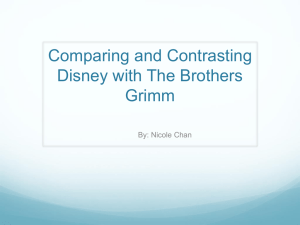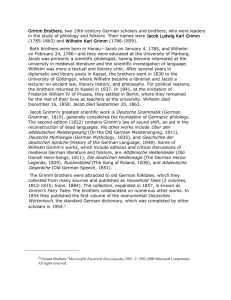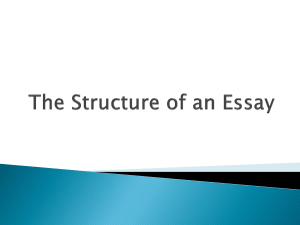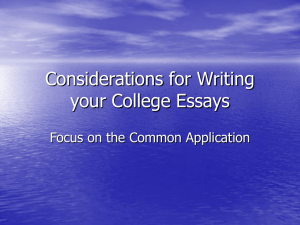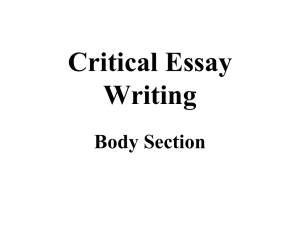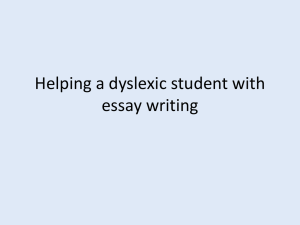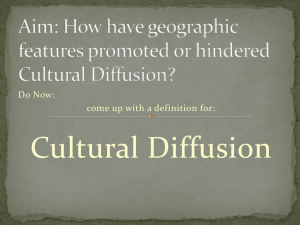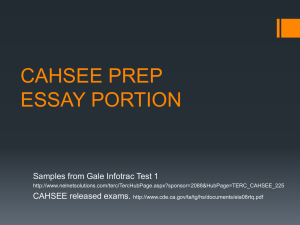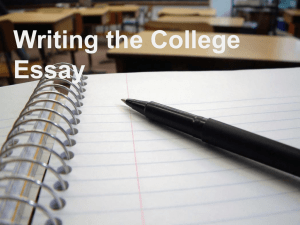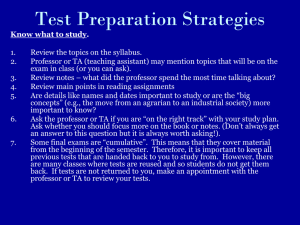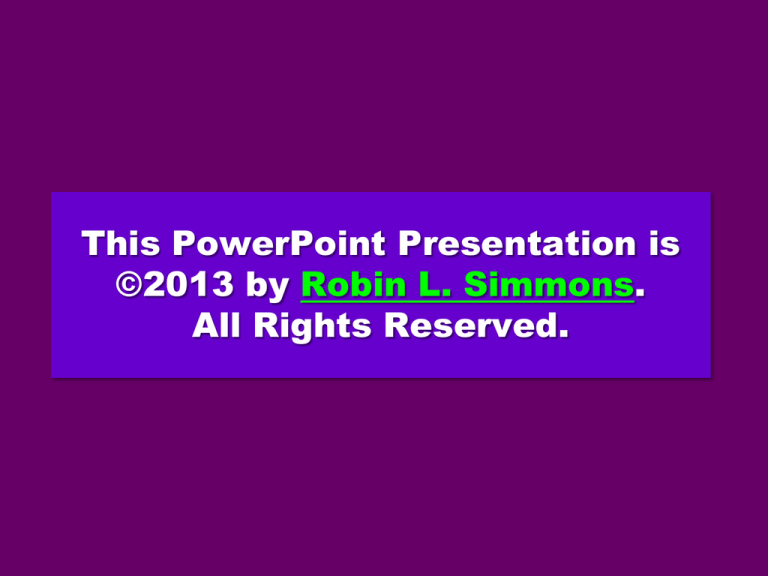
This PowerPoint Presentation is
©2013 by Robin L. Simmons.
All Rights Reserved.
ENC 1101,
Freshman Composition I
Instructions for the
Comparison or Contrast Essay
Do I want
this car … ?
… or do I
want that
other
car?
Do I want
this guy … ?
… or do I
want that
guy?
Do I want to visit
Egypt on my
next vacation … ?
… or do I want
to go to Las
Vegas?
Do I want to eat
something
healthy… ?
… or do I want
something
bad?
Understand what comparison or
contrast requires you to do.
Always choose two equal items—two cars,
two vacations, two sports stars—not two
unequal items, like a car and an octopus.
Next, decide if you want to compare or
contrast as your primary strategy. The
essay should be 80/20 in favor of one
strategy, not 50/50.
Your job is to interest the reader. Choose
points to discuss that are not immediately
obvious.
Now let’s test
your
understanding ...
A baby is like a vacuum cleaner.
WRONG!
Yeah,
baby!
Even though my little brother
Fred is 20 years my junior, he
and I have much in common.
My sister and I look alike, have
common hobbies, and enjoy the
same foods.
Boring!
Even though Venus and Serena Williams are
both professional tennis stars, they differ in
their opinions about men, movies, and music.
Excellent!
Make the comparison or
contrast interesting.
Be sure that your essay has a purpose.
Ask yourself this important question: Why
would anyone want to read this comparison
or contrast?
Consider giving the essay a specific
audience. Imagine the essay is a letter to
a specific person.
Dear Mom and Dad,
My current car is a death trap! Do you want me
to be the reason I-4 traffic is at a standstill? For this
reason, I want you to consider helping me pay for my
dream car, a 2011 Honda Accord …
Pick a pattern for your essay.
Pattern A is a
typical 5-paragraph
essay.
The thesis statement
will read like this:
Because of X, Y,
and Z, Subject A
is similar to [or
different from]
Subject B.
Each body paragraph
will discuss both
Subject A and
Subject B.
Introduction
All about Point X
All about Point Y
All about Point Z
Conclusion
Pattern B will look a bit different.
Pattern B has only
4 paragraphs.
Alas, the essay must
still be 500 words.
The thesis statement
should not include
restrictions, like this:
Subject A is
similar to [or
different from]
Subject B.
One body paragraph
will discuss X, Y, and
Z for Subject A; the
other body paragraph
will do the same for
Subject B.
Introduction
All about Subject A
All about Subject B
Conclusion
Format the Pattern A outline
correctly.
I. Point X
A. Subject A
1. Detail 1
2. Detail 2
3. Detail 3
B. Subject B
1. Detail 1
2. Detail 2
3. Detail 3
Roman numerals
address the X, Y, and
Z from the thesis
statement.
Capital letter A is
always for the first
subject; capital
letter B is always for
the second
subject.
A detail for Subject A
must correspond to a
detail for Subject B.
Thesis statement: The two stories of Cinderella, one
from Disney and the other from the Grimm Brothers, have
three important points of contrast: X, Y, and Z. Because of
these differences, I would read the Grimm version to my
snotty niece Beatrice.
I. Point X
A. Disney
1.
2.
3.
B. Grimm
Brothers
1.
2.
3.
II. Point Y
A. Disney
1.
2.
3.
B. Grimm
Brothers
1.
2.
3.
III. Point Z
A. Disney
1.
2.
3.
B. Grimm
Brothers
1.
2.
3.
Decide the topic for your
Pattern A outline:
Your first outline will discuss the differences
between the Disney version of Cinderella or
Snow White and the corresponding Brothers
Grimm version.
Disney
Grimm
VS
Brothers
Consider these points of
comparison or contrast:
Characters
Animals
Costume and setting
Violence
Parents and step-parents
Lessons
Reading and viewing
Remember that you need
a purpose for the
contrast. So decide
which fairytale version
you would share with a
specific child.
Thesis statement: The two stories of Cinderella, one
from Disney and the other from the Grimm Brothers, have
three important points of contrast: X, Y, and Z. Because of
these differences, I would read the Grimm version to my
snotty niece Beatrice.
I. Point X
A. Disney
1.
2.
3.
B. Grimm
Brothers
1.
2.
3.
II. Point Y
A. Disney
1.
2.
3.
B. Grimm
Brothers
1.
2.
3.
III. Point Z
A. Disney
1.
2.
3.
B. Grimm
Brothers
1.
2.
3.
Create a works cited page:
Use MLA-style page numbering: your last name
and the page number.
The works cited page is the last page of the essay.
Title the page: Works Cited.
The entire page is double spaced [with no extra
spacing between entries].
For each entry, all lines after the first are indented
five spaces.
Punctuation and capitalization require your careful
attention.
The list of entries is alphabetized.
Note the format:
Williams 4
Works Cited
The Greatest Movie Ever Made. Dir. John
Bowman. Funtime Studios, 2010. DVD.
Robertson, Zachary. “Wow Story.” The
Greatest Website Ever Made. Web. 23
Oct. 2013.
For a movie, the entry
needs this information:
The Title. [in italics]
Dir. Director’s First Name and
Last. [Dir. stands for Directed by.]
Studio Name, Year of
Release.
Publication Medium.
The entry will look like this:
Title of Film. Dir. Director’s
First and Last Name. Studio
Name, Year of Release. DVD.
Your two movie options:
Title: Cinderella
Directors: Clyde
Geronimi, Wilfred
Jackson, and
Hamilton Luske
Studio: Walt
Disney Pictures
Year: 1950
Title: Snow White
and the Seven
Dwarfs
Director: David
Hand
Studio: Walt
Disney Pictures
Year: 1937
For a document within a
website, the entry needs
this information:
Author’s last name, first name.
“Title of Story.” [in quotation marks]
Title of Website. [in italics]
Publication Medium.
Date accessed. [Day Month Year]
The entry will look like this:
Author’s Last Name, First Name.
“Title of Story.” Website
Name. Web. 23 Oct. 2013.
Your author information:
Authors: Jacob Grimm and Wilhelm
Grimm
Title: “Cinderella” or “Little Snow White”
Website: National Geographic
A Pattern B outline looks a little different:
Thesis Statement: Subject A is different from/similar to Subject B.
I.
Subject A
A. First Point of C/C
1. Detail
2. Detail
3. Detail
B. Second Point of C/C
1. Detail
2. Detail
3. Detail
C. Third Point of C/C
1. Detail
2. Detail
3. Detail
II.
Subject B
A. First Point of C/C
1. Detail
2. Detail
3. Detail
B. Second Point of C/C
1. Detail
2. Detail
3. Detail
C. Third Point of C/C
1. Detail
2. Detail
3. Detail
Pattern B Outline Topics:
Expectation vs. Reality
Vacation
Class
Date
Car
Friend
Pet
Job
Computer
School
Scholarship
Church
Concert
Sports event
Membership
Your Pattern B outline
is due at the beginning
of our next class.
Commit to either
Pattern A or B. Then
draft a thesis statement
for your essay.
Current method of
transportation vs. your
dream car.
Because of X, Y, and Z,
Subject A is different from
Subject B.
Subject A is different from
Subject B.
Separate your car
articles into two piles:
those that have an
author and those that
don’t.
For a document with an
author, the entry needs this
information:
Author’s last name, first name.
“Title of Article.” [in quotation
marks]
Title of Website [in italics]
Original Date of Publication.
Publication Medium.
Date accessed. [Day Month Year]
The entry will look like this:
Patton, Phil. “Reimagining a
Brawny Jeep for a Less
Rugged Landscape.” New
York Times 12 Dec. 2013.
Web. 2 July 2014.
If you don’t have an
author, begin with the
article title, like this ...
“New Cars for 2014: Jeep.”
Car and Driver. Web. 2
July 2014.
Now alphabetize
your cards.
Draft and type your real
works cited page.
To earn all of the points
you need a nearly
flawless document. You
get one free format
error and one free entry
error—and that’s it.
Use Ctrl + T
for perfect indentions.
See how this works.
See how this works again.
On your “Integration and
Documentation” handout,
list the three areas that
you plan to contrast in
your essay.
Consider these points
of contrast:
Convenience
Safety
Speed
Accessories
Comfort
Passengers
Gas mileage, etc.
You will add
support to your essay
with direct quotations:
authority tag + quotation
+ documentation.
Introducing a Quotation
Every quotation must begin with an
authority tag.
A good option is to use the source in
your authority tag:
According to Car and Driver,
As Car and Driver explains,
Car and Driver makes this point:
Car and Driver notes that … (no
punctuation)
Choosing a Quotation
Use the exact words from the source
in quotation marks.
You can make small changes if you
enclose the changes in brackets like these:
[ ]
You can omit chunks of text with ellipses.
Use three periods in a row to indicate that
you have removed words in the middle or at
the end.
Together, the authority tag +
quotation should form a smooth,
logical, grammatically correct sentence.
Documenting the Quotation
Follow with an in-text citation [aka
parenthetical reference]
If you have an author, use the last name in
parentheses: (Quiroga)
If you do not have an author, use the
abbreviated title of the article in
parentheses: (“2014 Mazda 3”)
Citations help convince your reader that
you haven’t committed plagiarism, a
serious academic offense.
Format the quotations like this:
According to _____ [source title and/or author],
“Exact words” (In-text citation).
As __________ [source title and/or author]
claims, “Exact words” (In-text citation).
According to Motor Trend, the Mazda3 has “an
EPA rating of 30 mpg in the city and 41 on the highway”
(“2014 Mazda3”).
As Car and Driver claims, “[T]he 155-hp engine has
enough muscle to pull itself to freeway speeds without
eliciting any worry from the driver. . . . There’s no waiting
for the power to arrive [in the Mazda3], but rather a
smooth, steady stream of pull” (Quiroga).
Draft the introduction.
Tell a very brief story that indicates a
problem with your current method of
transportation.
This story should lead up to your thesis
statement, which explains that your
current method of transportation is
different from your dream car.
Write a minimum of 8 sentences. Don’t
go overboard with the story.
Bring the introduction to me.
Blend your personal
information with the
quotations you wrote.
My first and foremost concern in choosing my dream
vehicle is safety. Since I regularly chauffeur the very precious
cargo of my eight-year-old daughter, I want to make sure that the
crash test ratings are adequate to appease my concerns about
being in an accident. I am happy to report that the 2013 Ford
Focus Electric was a top safety pick for the year 2013 in three
safety categories. Moderate overlap front test results, side impact
test results, and roof strength test results all scored a “Good”
(“IIHS-HLDI: Ford Focus”). I never want to be in a vehicle
collision, but knowing that I am driving in a vehicle with a high
safety rating does calm my worries about my passengers
surviving a major collision.
First Draft Directions
To earn all of the points on your prewriting
sheet, do the following:
Be sure to include a correct heading at the
top left of the first page.
Be sure that the essay has a correct and
interesting title.
Remember that rough drafts can be
messy.
Be sure that you reach the conclusion and
have 500+ words.
Be sure to work in at least three
quotations with in-text citations.
Prepare the final draft of the
essay.
Be sure that you have MLA-style page
numbering on every page.
The works cited page should be the last page of
the essay.
Confirm that you have three quotations—correctly
integrated and cited—from your print source.
Know how many points each skill is worth on the
evaluation sheet.
Visit the Writing Center [5-155] for advice.
Be sure to read and follow all of the format
guidelines on your syllabus.
Upload the essay to SafeAssign before you arrive
to class!
The End.

